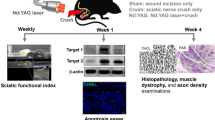Abstract
Objective
To evaluate the delayed effects of irreversible electroporation (IRE) ablation on nerves.
Methods
The study was approved by the institutional animal care and use committee. CT-guided IRE-ablation (electric field per distance, 1,500 V/cm; pulse length, 70 μs; number of pulses, 90) of 6 sciatic nerves was performed in 6 pigs that were euthanized 2 months after ablation. The sciatic nerves were harvested immediately after euthanasia for histopathological evaluation. Sections from selected specimens were stained with haematoxylin and eosin (H&E), Masson’s trichrome (MT) method for collagen, and immunohistochemistry was performed for S100 and neurofilaments (markers for Schwann cells and axons, respectively).
Results
All nerves showed a preserved endoneural architecture and presence of numerous small calibre axons associated with Schwann cell hyperplasia, consistent with axonal regeneration. A fibrous scar was observed in the adjacent muscle tissue, confirming ablation at the site examined.
Conclusion
After IRE-ablation of nerves, the preservation of the architecture of the endoneurium and the proliferation of Schwann cells may enable axonal regeneration as demonstrated after 2 months in this study.
Key Points
• Irreversible electroporation (IRE) offers promise for non-thermal tumour ablation.
• Preservation of endoneural architecture and proliferation of Schwann cells follow IRE-ablation.
• Preservation of architecture and proliferation of Schwann cells may enable axonal regeneration.
• Despite morphological regeneration, nerve function remains variable after 2 months.

Similar content being viewed by others
References
Lee EW, Chen C, Prieto VE, Dry SM, Loh CT, Kee ST (2010) Advanced hepatic ablation technique for creating complete cell death: irreversible electroporation. Radiology 255:426–433
Rubinsky B, Onik G, Mikus P (2007) Irreversible electroporation: a new ablation modality–clinical implications. Technol Cancer Res Treat 6:37–48
Deodhar A, Monette S, Single WG Jr et al (2011) Renal tissue ablation with irreversible electroporation: preliminary results in a porcine model. Urology 77:754–760
Schoellnast H, Monette S, Ezell PC et al (2011) Acute and subacute effects of irreversible electroporation on nerves: experimental study in a pig model. Radiology 260:421–427
Geuna S, Raimondo S, Ronchi G et al (2009) Chapter 3: histology of the peripheral nerve and changes occurring during nerve regeneration. Int Rev Neurobiol 87:27–46
Li W, Fan Q, Ji Z, Qiu X, Li Z (2011) The effects of irreversible electroporation (IRE) on nerves. PLoS One 6:e18831
Arena CB, Sano MB, Rossmeisl JH Jr et al (2011) High-frequency irreversible electroporation (H-FIRE) for non-thermal ablation without muscle contraction. Biomed Eng Online 10:102
Acknowledgments
SB Solomon received grants from Angio Dynamics, GE Healthcare, Johnson & Johnson and G Single is an employee of Angio Dynamics.
Author information
Authors and Affiliations
Corresponding author
Rights and permissions
About this article
Cite this article
Schoellnast, H., Monette, S., Ezell, P.C. et al. The delayed effects of irreversible electroporation ablation on nerves. Eur Radiol 23, 375–380 (2013). https://doi.org/10.1007/s00330-012-2610-3
Received:
Revised:
Accepted:
Published:
Issue Date:
DOI: https://doi.org/10.1007/s00330-012-2610-3




